The Demolition Phase :
|
| Trev and Flo had unusual retirement plans. They constructed a magnificent forty-four foot ketch right on the shore at Race Rocks. During seven years of construction, Trev had the fledgling hull secured by heavy cables to eyes driven into the rocks to prevent a shipwreck from the winter North East storms before she was even launched. While she was under construction the sailboats ribs looked more like a beached whale. |
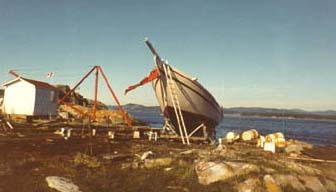 On February 7, 1982 Wawa the Wayward Goose was launched and the Andersons set off on a two year voyage that took them north to the Queen Charlottes and across the Pacific to New Zealand and back aboard their Race Rocks built sailboat.
On February 7, 1982 Wawa the Wayward Goose was launched and the Andersons set off on a two year voyage that took them north to the Queen Charlottes and across the Pacific to New Zealand and back aboard their Race Rocks built sailboat.
 Lester B. Pearson College was established in nearby Pedder Bay in 1974. Students from around the world came to study at the College which was named in memory of the former Canadian Prime Minister and Nobel Prize winner. The College was established to promote international understanding. All students attended Pearson College on full scholarship and came from everywhere; from Papua New Guinea to Poland. It wasn’t long until the students started to visit Race Rocks as Pearson College operated a much needed rescue service in the area. Faculty and students in marine biology classes and in the Diving Service began to study the extraordinary marine life at Race Rocks. It became clear that the fast flowing, nutrient rich waters supported large, diverse populations of marine life. After over a century of protecting others, Race Rock was in fact in need of protection itself. From 1978 on, they urged the faculty and students to seek formal protection for the natural environment and the rich biodiversity of the area. In 1980, after Pearson College students and faculty worked with the Ecological Reserves office of the (then) Department of Lands, Parks and Housing, the Race Rocks Ecological Reserve was established by an order in Council of the Cabinet of the Provincial Government in British Columbia. In the few years preceding this, the Andersons had assisted the students in every way they could and kept a watchful eye over the area.
Lester B. Pearson College was established in nearby Pedder Bay in 1974. Students from around the world came to study at the College which was named in memory of the former Canadian Prime Minister and Nobel Prize winner. The College was established to promote international understanding. All students attended Pearson College on full scholarship and came from everywhere; from Papua New Guinea to Poland. It wasn’t long until the students started to visit Race Rocks as Pearson College operated a much needed rescue service in the area. Faculty and students in marine biology classes and in the Diving Service began to study the extraordinary marine life at Race Rocks. It became clear that the fast flowing, nutrient rich waters supported large, diverse populations of marine life. After over a century of protecting others, Race Rock was in fact in need of protection itself. From 1978 on, they urged the faculty and students to seek formal protection for the natural environment and the rich biodiversity of the area. In 1980, after Pearson College students and faculty worked with the Ecological Reserves office of the (then) Department of Lands, Parks and Housing, the Race Rocks Ecological Reserve was established by an order in Council of the Cabinet of the Provincial Government in British Columbia. In the few years preceding this, the Andersons had assisted the students in every way they could and kept a watchful eye over the area.
( Go to this file for a more detailed history of the establishment of the Ecological Reserve.)
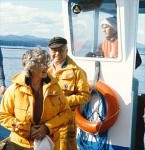 After a short interval after the departure of the Anderson’s in 1982, when the station was covered by relief keepers, the Redheads took over at Race Rocks. They served more than the station during their tenure; they served muffins! Several generations of Pearson College students the world over still remember hot chocolate and muffins in their kitchen, after a cold scuba dive. Charles and Joan Redhead continued the strong interest in protecting the ecology of Race Rocks. For a few years before retirement, they shared the island with the assistant lightkeepers Warren and Elaine Kennedy. All four keepers often turned out to greet the students as they came ashore. See updates in the file on these four lightkeepers
After a short interval after the departure of the Anderson’s in 1982, when the station was covered by relief keepers, the Redheads took over at Race Rocks. They served more than the station during their tenure; they served muffins! Several generations of Pearson College students the world over still remember hot chocolate and muffins in their kitchen, after a cold scuba dive. Charles and Joan Redhead continued the strong interest in protecting the ecology of Race Rocks. For a few years before retirement, they shared the island with the assistant lightkeepers Warren and Elaine Kennedy. All four keepers often turned out to greet the students as they came ashore. See updates in the file on these four lightkeepers
- MIKE AND CAROL SLATER-The last lightkeepers of Race Rocks 1990-1997In 1990 the head keeper Mike Slater and his wife Carol came to the station. Carol in particular held strong views about the need to live in harmony with the nature that truly surrounds Race Rocks. The Slaters worked hard to protect the reserve and assist researchers. These volunteer activities fall far outside their regular lightstation duties. During the early 1990’s the ominous signs of the first radical change at Race Rocks became apparent as the Coast Guard experimented with automated equipment to operate the station.
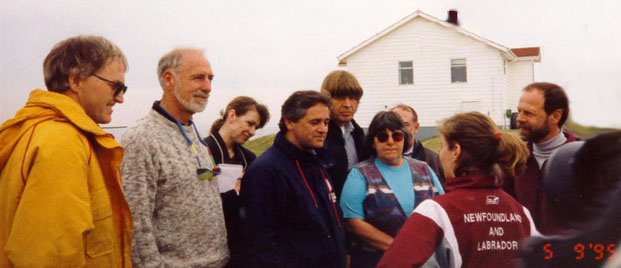 In the spring of 1994 the first announcements about de-staffing of lightstations on the British Columbia Coast were made. The decision was surprising and unpopular. In September, 1995, the Minister of Fisheries, Brian Tobin and the MP for Victoria and Environment Minster David Anderson paid a visit to the island and are shown here talking with Mike and Carol Slater and Garry Fletcher and Mike Hobbis, and Pearson students. Most surprising, a few months later was the announcement that Race Rocks was on the list of the seven stations to be de-staffed in the first round of budget cuts. Race Rocks was to be closed on March 1st 1997. Mike and Carol watched as the last of the automated equipment was installed and a maintenance crew measured the windows of their house for shutters. They might as well have measured the keepers for a box too as the end of a way of life would be coming to Race Rocks.
In the spring of 1994 the first announcements about de-staffing of lightstations on the British Columbia Coast were made. The decision was surprising and unpopular. In September, 1995, the Minister of Fisheries, Brian Tobin and the MP for Victoria and Environment Minster David Anderson paid a visit to the island and are shown here talking with Mike and Carol Slater and Garry Fletcher and Mike Hobbis, and Pearson students. Most surprising, a few months later was the announcement that Race Rocks was on the list of the seven stations to be de-staffed in the first round of budget cuts. Race Rocks was to be closed on March 1st 1997. Mike and Carol watched as the last of the automated equipment was installed and a maintenance crew measured the windows of their house for shutters. They might as well have measured the keepers for a box too as the end of a way of life would be coming to Race Rocks.
For the time being Race Rocks and its keepers won a reprieve. In an emergency two year agreement Pearson College undertook to operate the facility in cooperation with the Coast Guard, as an education centre. A private donor agreed to cover the salary costs for the Slaters who were invited to stay on at Race Rocks by Pearson College. The College continued negotiations with the Provincial Government, the actual owners of the land, to operate the facility on a long term basis. Seventeen years later, Lester B. Pearson College is still managing the island on a long term lease from BC Parks.
They have to raise the funding and manage all utilities and repairs on the island without government help and are determined to make the island self-sufficient. With that in mind, the Race Rocks endowment fund has been set up for operating racerocks.
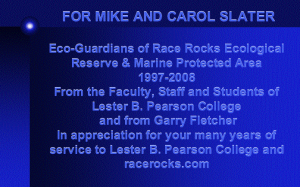 In December of 2008, Mike and Carol Slater retired from Race Rocks where they had been employed by Lester Pearson College as the Ecological Reserve and MPA Guardians since 1997. This Powerpoint presentation touches on some of the aspects of their life in the last few years at Race Rocks.
In December of 2008, Mike and Carol Slater retired from Race Rocks where they had been employed by Lester Pearson College as the Ecological Reserve and MPA Guardians since 1997. This Powerpoint presentation touches on some of the aspects of their life in the last few years at Race Rocks.
- During the following years, from 1997 to 2000, The Canadian Coast Guard and the Provincial Parks Department started the process of transferring the property, upgrading essential parts and restoring some of the areas used by the Coastguard back to a natural ecosystem.
- In 2001, Great Race Rocks was added to the Ecological reserve.
- In September of 1998, The Minister of Oceans and Fisheries, the Honourable David Anderson, announced the proposal to make the Ecological reserve and all the Islands of Race Rocks into a Pilot Marine Protected Area (pilot MPA) for eventual designation as a Marine Protected Area ( MPA) under the Ocean’s Act. This index contains the information on that prolonged process.
- In recognition of the FirstNations role in Race Rocks, A process of involving the Coast Salish people in the educational program for the Race Rocks MPA was started. .The Race Rocks Advisory Board with First Nations representation was set up in the fall of 1999 to further the creation of the MPA.
- See this file for information on Administration of the Islands
I wish to acknowledge the assistance of the British Columbia Archives in making the photos from the early years on Race Rocks available to us, and Trev and Flo Anderson, and Joan Redhead for the more recent pictures.

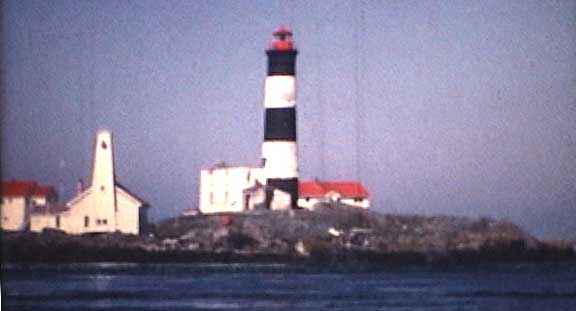 The demolition by the Canadian Coast Guard of some of the historic structures on the island in the 1960’s and 1970’s
The demolition by the Canadian Coast Guard of some of the historic structures on the island in the 1960’s and 1970’s